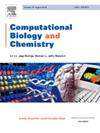Accelerating drug discovery targeting dihydroorotate dehydrogenase using machine learning and generative AI approaches
IF 2.6
4区 生物学
Q2 BIOLOGY
引用次数: 0
Abstract
Dihydroorotate dehydrogenase (DHODH) is a key enzyme in pyrimidine biosynthesis, making it an attractive drug target for cancer, autoimmune diseases, and infections. Traditional DHODH inhibitor discovery is slow and costly. Our study integrated machine learning (ML) and generative artificial intelligence (AI) to accelerate this process, enhancing efficiency and reducing costs. We employed Random Forest (RF), XGBoost (XGB), and Logistic Regression (LR) to predict pIC50 values, with RF achieving the highest accuracy (93 % test accuracy, 81 % on unseen molecules), demonstrating superior generalization. Using a Graph Convolutional Network-based Variational Autoencoder (GCN-VAE), we generated 59 unique drug-like molecules, five with pIC50 > 7, expanding the chemical space beyond conventional screening.
Docking studies confirmed strong binding affinities, with the most promising newly generated molecule showing a binding energy of –11.1 kcal/mol and an inhibition constant (Ki) of 269.8 nM. Key interactions with residues such as ALA59, PHE36, TYR38, GLN47, and ARG36 further validated stability and inhibitory potential. This AI-driven workflow accelerates DHODH inhibitor discovery by significantly reducing screening time, enhancing molecular diversity, and improving predictive accuracy. Our approach presents a scalable, cost-effective strategy for developing novel therapeutics, offering a transformative shift in drug discovery.
使用机器学习和生成式人工智能方法加速针对二氢羟酸脱氢酶的药物发现
二氢羟酸脱氢酶(DHODH)是嘧啶生物合成的关键酶,使其成为癌症、自身免疫性疾病和感染的有吸引力的药物靶点。传统的DHODH抑制剂的发现是缓慢和昂贵的。我们的研究整合了机器学习(ML)和生成式人工智能(AI)来加速这一过程,提高效率并降低成本。我们使用随机森林(RF)、XGBoost (XGB)和逻辑回归(LR)来预测pIC50值,其中RF达到了最高的准确度(93 %的测试准确度,81 %的未见分子),显示出卓越的泛化性。使用基于图卷积网络的变分自编码器(GCN-VAE),我们生成了59种独特的药物样分子,其中5种具有pIC50 >; 7,扩展了传统筛选之外的化学空间。对接研究证实了较强的结合亲和力,最有希望的新生成分子的结合能为-11.1 kcal/mol,抑制常数(Ki)为269.8 nM。与ALA59、PHE36、TYR38、GLN47和ARG36等残基的关键相互作用进一步验证了其稳定性和抑制潜力。这种人工智能驱动的工作流程通过显著缩短筛选时间、增强分子多样性和提高预测准确性,加速了DHODH抑制剂的发现。我们的方法为开发新型疗法提供了一种可扩展的、具有成本效益的策略,为药物发现提供了革命性的转变。
本文章由计算机程序翻译,如有差异,请以英文原文为准。
求助全文
约1分钟内获得全文
求助全文
来源期刊

Computational Biology and Chemistry
生物-计算机:跨学科应用
CiteScore
6.10
自引率
3.20%
发文量
142
审稿时长
24 days
期刊介绍:
Computational Biology and Chemistry publishes original research papers and review articles in all areas of computational life sciences. High quality research contributions with a major computational component in the areas of nucleic acid and protein sequence research, molecular evolution, molecular genetics (functional genomics and proteomics), theory and practice of either biology-specific or chemical-biology-specific modeling, and structural biology of nucleic acids and proteins are particularly welcome. Exceptionally high quality research work in bioinformatics, systems biology, ecology, computational pharmacology, metabolism, biomedical engineering, epidemiology, and statistical genetics will also be considered.
Given their inherent uncertainty, protein modeling and molecular docking studies should be thoroughly validated. In the absence of experimental results for validation, the use of molecular dynamics simulations along with detailed free energy calculations, for example, should be used as complementary techniques to support the major conclusions. Submissions of premature modeling exercises without additional biological insights will not be considered.
Review articles will generally be commissioned by the editors and should not be submitted to the journal without explicit invitation. However prospective authors are welcome to send a brief (one to three pages) synopsis, which will be evaluated by the editors.
 求助内容:
求助内容: 应助结果提醒方式:
应助结果提醒方式:


